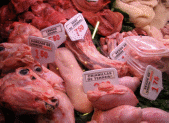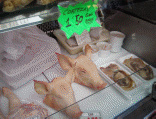Introduction
Bacterial food toxicity refers to the extent to which bacteria can damage organs of persons who ingest food or fluids contaminated with different species of bacteria that are known to cause toxicity. The concept of bacterial toxicity in food is that the biological effects caused by the microorganisms are dose-dependent. Thus, more bacteria could cause higher levels of toxicity than a small number of bacteria. The level of bacterial food toxicity in human beings is also greatly determined by the host’s immune response. Therefore, a similar number of bacteria ingested in food could result in different levels of biological damage in different people. Bacteria are examples of biological toxicants that cause disease in living organisms. This paper focuses on the major types of bacteria that cause food toxicity and their modes of action.
Bacillus cereus
Bacillus cereus bacterium is a rod in appearance and is characterized by spores. It produces two types of toxins that are important in food toxicology. One type of toxin is large proteins that are destroyed by heat. The biological toxicity caused by this toxin is similar to that induced by Clostridium perfringens. The other type of toxins produced by the bacterial rod is marked by a high level of heat stability and low molecular weight. The light peptides of the toxin have been shown to cause severe emetic reactions that result in high levels of toxicity associated with eating contaminated food. Bacillus cereus bacterium induces toxicity when the two types of toxins are released into the gastrointestinal tract. The toxicity caused by the microorganism is mild and manifests through the following symptoms:
- Diarrhoea
- Vomiting
- Nausea
- Pain in the lower abdomen
There are two mechanisms of action that have been shown to cause toxicity. First, the B-component of Bacillus cereus toxins binds to the host cells via special ligands. Subsequently, the L-component gains entry into the target cells, a process that is followed by changes in the metabolic activities of the cells. The alterations of the metabolic functions of the cells result in clinical symptoms. Second, the B-component of the toxins binds to the receptors of the target cells, followed by the formation of pores in the cell membrane. The process of forming lesions is mediated by both the B- and L components of the bacterial toxins. The most common symptom of Bacillus cereus toxicity, diarrhea, is caused by the following processes:
- Components of the toxins bind to the cell membrane receptors.
- Conduction of signals across the cell membrane.
- Induction of the production of chemical messengers.
- Disturbance of electrolyte and water exchange dynamics, is a process that leads to an excess amount of water in the lumen of the intestines.

Figure 1 demonstrates that chicken might be lead to food toxicity as a result of undercooking methods.
Campylobacter jejuni
Campylobacter jejuni bacterium is regarded as the cause of toxicity with regard to food that results in human diarrhoea across the world, particularly experienced by infants in the third world countries. The disease-causing organisms are transferred through contaminated water and undercooked food like chicken, among others. Toxicity of the bacterium is exhibited through the following symptoms:
- Diarrhoea
- Bloody stool
- Body malaise
- Fever
- Vomiting
C. perfringens bacterium produces spores that are implicated in food toxicity. The bacterial rod has the following types of toxins: A, B, C, D, and E. Among these, the A toxin is the most important agent of food toxicity. It is also known as phospholipase C and it induces gastroenteritis by initiating the breakdown of phospholipids in the cell membranes. The toxin causes alterations in the biological functions of cells by interfering with the intestinal transport of fluids and ions, which leads to gastrointestinal damage. Also, the toxin inhibits physiological activities in the tissues of the human host. In addition, the spores alter the basic macromolecular synthesis and structural organisation of cells.
Escherichia coli
E. coli bacterium is an important normal microorganism in the human body. The enteropathogenic E. coli (EPEC) strains produce lethal toxins that are associated with contaminated food. The toxins induce diarrhoea that is accompanied by blood and lower abdominal pain. In some cases, the toxicity caused by the bacteria could result in haemolytic syndrome, a condition that could result in death a few hours after it starts to manifest. Although some pathways through which toxins of the E. coli bacterium causes toxicity have not been well defined, it is generally accepted that verotoxins adhere to the walls of the host cells in the intestines. This alters the physiological activities of the intestinal cells. Salmonella, E. coli, campylobacter and L. monocytogenes have been closely monitored with regard to food toxicology. Their contributions to toxicity in human beings are shown in the following figure:

Figure 2 shows the contributions of various species of bacteria to food toxicity.
The mechanism of action of E. coli could be best explained using the molecular events that take place in the intestines. Once the bacterium is in the intestines, it produces the shiga toxin that has the ability to destroy RNA components of ribosomes. The destruction results in a cessation of protein synthesis, thus leading to cell death. Although there is cell death, the vascular endothelium renews the killed cells, a process that culminates in the destruction of the cell lining and internal bleeding that is exhibited through bloody diarrhoea.

Figure 3 indicates that food materials might acquire bacteria due to poor freezer storages.
Vibrio cholerae
The bacterium is Gram-negative, and it is known to be the cause of cholera in human beings. The toxic species of V. cholerae are spread via contaminated faecal waste, water and food. Cholera toxin may induce profuse diarrhoea in people seeming very sick or mild diarrhoea that could characterise asymptomatic patients. With regard to toxicity caused by V. cholerae, colonisation of the small intestines with the pathogenic bacteria is the first stage that marks the infection process. The process stimulates the production of water from the intestinal wall. The bacterium produces the enzyme neurominidase, which is essential in defining the pathogenic pathways of the microorganism and promoting the effect of the toxin in cases of low production.

Figure 4 indicates how meat might be contaminated as it is transported to markets. Such meat should be well cooked to kill all types of bacteria.
Conclusion
Bacteria are important aspects of biological toxicants that are associated with contaminated food. The level of bacterial food toxicity is dependent on the dose (the amount of bacteria that gets into the alimentary canal). The bacillus aureus bacterium produces both heat stable and heat labile toxins that cause toxicity in people when ingested in combination with contaminated food materials. Campylobacter bacterium is the leading cause of diarrhoea in infants, particularly in the third world countries. It is acquired via undercooked food. E. coli does not cause toxicity in healthy individuals, however, in immunologically compromised persons, the EPEC toxins of the bacterium causes toxicity. V. cholerae is characterised by about 10 species, which cause cholera. The bacterium is transferred through contaminated water and food.